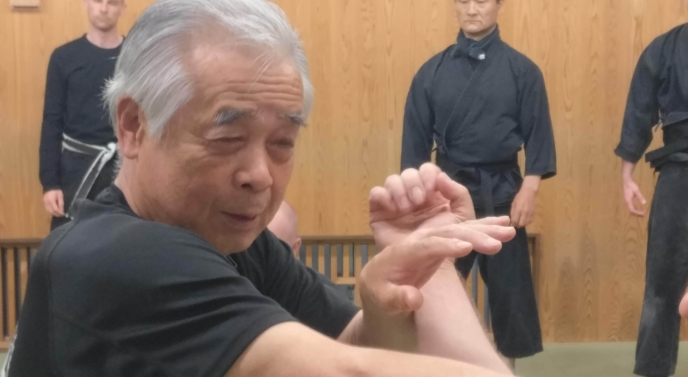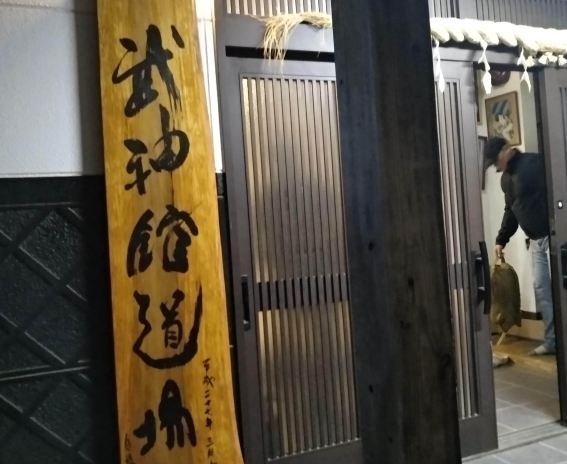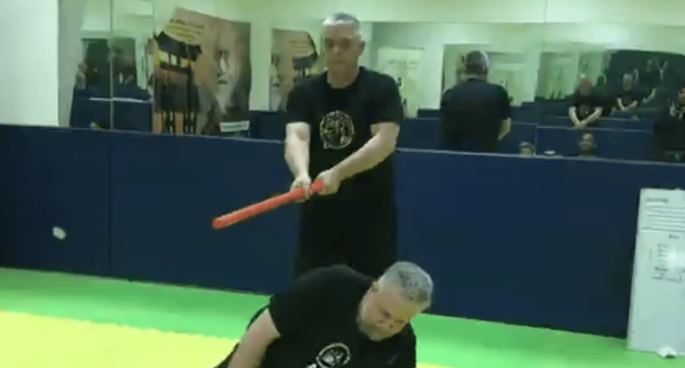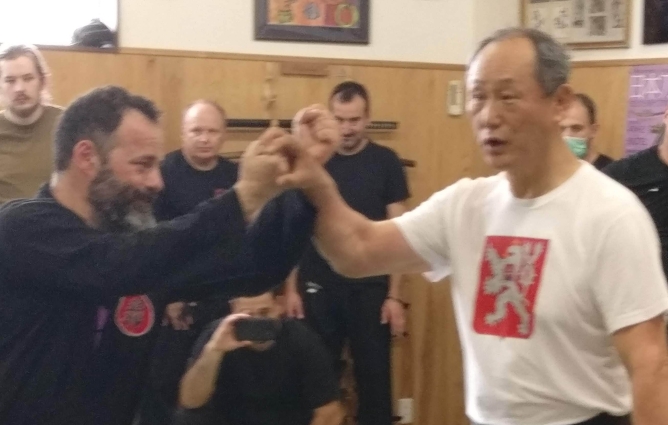Are You An Eccentric?
From Shiro Kuma by kumablog

Disclaimer: The class was so dense that this article might be a little too long. Sorry about that.
A class with Sōke these days is a succession of many moments. Relying on the Dai Shihan to show the techniques, he gives his advice from his chair. He only shows when a move requires his expertise.
Also, he often begins the class by showing the new swords he bought for his museum. He recently did a sword exhibition in Noda to explain to the public, the 200 blades he already has.
Friday night he displayed à few interesting Tantō that he got. Some of them had a Kozuka inserted in the scabbard. It was a first for me. (1)
Each time Sōke tells of being aware of the danger of live weapons. And shows the correct way to pass or receive a naked sword from hand to hand. Not aware of the distance, there is a danger to be cut or killed. The translators sometimes get too close to him, and some nearly got cut. When you receive a naked sword from someone, you have to be close enough to take it, but far enough not to be cut.
Sōke teaches us these things because he doesn’t want the Bujinkan Dai Shihan, to look stupid. He said that people training Kendō or other martial arts don’t know the dangers of live weapons. Because they lack awareness. The Japanese wars created our systems on the battlefield, not during peacetime in a Dōjō. (2)
We did some Waza with the Daishō, and Sensei stopped the class to teach us how to wear them. That was interesting as many practitioners do not have a clue there is a proper way of doing things. One thing to keep in mind is that our fighting systems originate from the military. In the military, they keep everything that works fine. They reject what doesn’t. Each time your teacher asks for a precise movement, try to understand the reason to do it that way. When you know the hidden reasons to do things, your Taijutsu improves. Nothing we do is by chance, there is always a reason behind.
How to wear the Daishō? (3) First, insert your thumb into the Obi and put the Kodachi, then put the Katana in this order. (4) Sōke asked us to train this to master it. He said the Dai Shihan, should have real blades to get better the essence of Mutō Dori. (5) We have to understand what is fake and what is real. He added that Takamatsu Sensei always showed him the practical aspects of Budō. The Bujinkan is not Gendai Budō, we don’t do sport. (6)
Sensei moved back to Taijutsu. After the technique, his Uke explained that he was so focused on the pain on his finger, that he didn’t see the rest. This is “Mienai.” Sensei was using his other hand to take Uke’s balance. (7) Mutō dori uses Kakushi waza whenever possible. (8) Uke can see is not what matters.
Against a knife attack, Sensei stopped the attacker and began to speak to us. Uke lost his concentration, and Sōoke peeled the knife from his grip. This is Metsubushi. (9) We use Metsubushi to confuse the opponent and are not limited to Ninja blinding powder. It can be physical or by talking. If you speak, Uke cannot avoid listening to you.
In unarmed combat, we rely too much on the hands. Sōke said that “Sebone,” the backbone, is what does the action. He asked us to try it and insisted on keeping a relaxed body and on keeping the legs unlocked. (10)
In the end, Sensei said that now the Daishihan are in charge. And if they don’t understand it is ok. Because when you get the movement by yourself, you are your own teacher. Let the action be, and do not overthink everything.
Ethics is the backbone of our soul, this is “Kikotsu.” (11) But when you only rely on physicality, you are not a Bujin but another “Kikotsu,” an eccentric. (12)
_________________________________________
1 Kozuka: This small knife was usually hidden in the Saya of a Katana, close to the Tsuba.
2 War Time vs. Peacetime: The Bujinkan systems are born during wartime (12th to 17th century). One exception is the Takagi Yōshin Ryū, formalized in the 18th century.
3 大小, Daishō: matched pair of long and short swords
4 The original Obi were larger and longer. Because of the length, there were at least three layers of belt. First, you put he Kodachi between the first layer close to the body and the second layer. Then you slide the Katana between the second and the third layer. This is a way to protect the lacquer on the Saya. This keeps the blade sealed in the scabbard and avoid humidity to damage the sword.
5 I have been using a real Katana for more than 30 years. I cut myself as expected. But when you have à real blade, you stop moving like they do in B movies. Never underestimate the danger of using a real weapon. The same goes for firearms and swords.
6 現代, nowadays; modern era; modern times; present-day.
現代武道, Gendai Budō: https://en.wikipedia.org/wiki/Gendai_bud%C5%8D
7 見えない技, Mienai Waza: Invisible technique (that Uke cannot see)
8 隠し技, Kakushi Waza: Technique for hiding; concealing; being hidden; being concealed
9 目潰し, Metsubushi: sand, ash, etc., thrown in the eyes to blind someone. Throwing something at someone’s eyes to blind them. Poking someone’s eyes during a fight to blind them. https://en.wikipedia.org/wiki/Metsubushi
10 背骨, Sebone: spine; backbone; spinal column
11 気骨, Kikotsu: (moral) backbone; spirit; soul; grit
12 奇骨, Kikotsu: eccentric





















